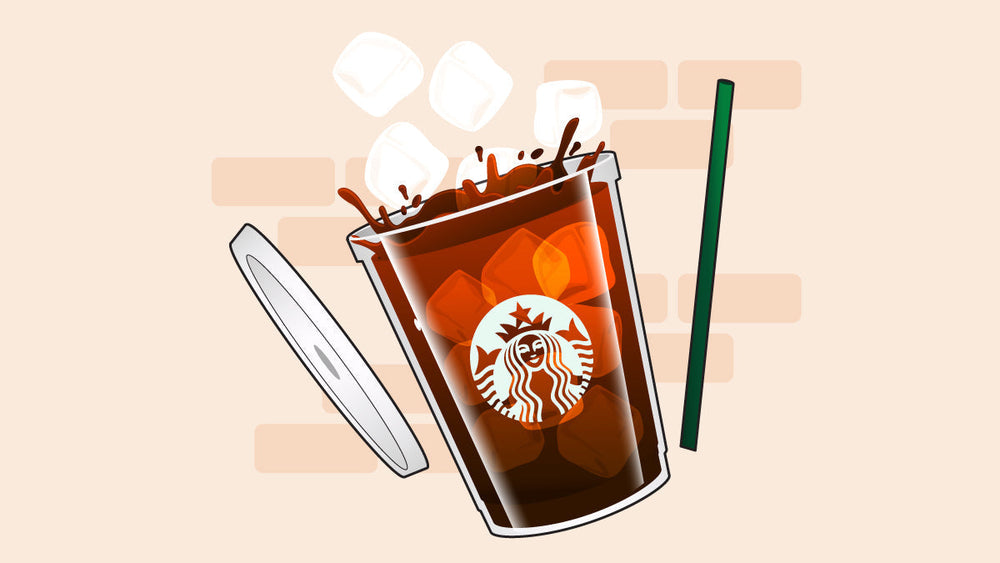While we like to champion drinking coffee at our local independent cafes, big chains like Starbucks are just about everywhere, making it quick and easy to get a coffee fix wherever you are.
But there’s a massive gap in Starbucks current menu — Vietnamese-style iced coffee (strong coffee mixed with condensed milk and ice).
You can’t order Vietnamese coffee from Starbucks directly, but there is a custom drink formula you can use to match the taste pretty closely.
This is by no means traditional, but the taste is similar and still pretty great.
Craving Real Vietnamese Coffee?
Skip the Starbucks hack and try our bold, less sugary Vietnamese Coffee 2.0 — boosted with ginseng and L-theanine for an all-day, jitter-free buzz.
How To Order Vietnamese Coffee At Starbucks
You'll need to get creative if you want to make a Vietnamese coffee at Starbucks. The magic comes together by combining syrups and strong shots.
Here’s the best recipe for a Starbucks Vietnamese coffee in a Venti (20 oz) cup:
- A quad shot of espresso over ice
- Four pumps of white chocolate mocha syrup
- Top with sweet vanilla cream foam
Despite this having nearly none of the original Vietnamese coffee ingredients, the espresso provides a similar strength and depth. The sweet vanilla cream foam gives a thick and silky sweetness similar to the texture offered by condensed milk.
The white chocolate mocha syrup further adds to this effect. It also helps add depth to the flavor to make up for the use of arabica coffee beans rather than the traditional robusta used for Vietnamese coffee.
How To Order Vietnamese Coffee On the Starbucks App

Luckily for all of us who are in a hurry, you can order a Vietnamese coffee on the Starbucks app and have it waiting when you arrive.
Simply add each component separately, starting with your quad shot of espresso base and then adding the syrup and foam on top. It’s as easy as that!
For the iced version, just select an iced quad shot of espresso instead and add the syrup and cream from there.
How Much Caffeine is in Vietnamese Coffee from Starbucks?

Four shots of espresso from Starbucks has about 300 mg of caffeine, but this is for the 20 oz size. You can always dial it back by going smaller.
Two shots have about 150 mg, and three shots have approximately 225 mg.
Just remember to adjust the syrup accordingly. You don’t want it too sweet, and the barista can always add more if you need it.
In comparison, traditional Vietnamese coffee is highly caffeinated — even though it’s usually a smaller amount ( 2-4 oz of coffee), it has between 66-130 mg of caffeine.
The reason for the higher caffeine in traditional Vietnamese coffee comes down to the type of beans used. Coffea robusta delivers roughly 2.5X as much caffeine as its arabica counterpart which is why Vietnamese coffee is so strong.
FAQs: Starbucks Vietnamese Coffee
Okay, now that we know how to order a Vietnamese coffee at Starbucks, let’s round off this guide with a few frequently asked questions.
1. What is the traditional way to make Vietnamese coffee?

While there’s no right or wrong way to make Vietnamese coffee, traditionally, it’s made with a high-quality robusta, like our HaNoi beans, and brewed with a phin filter.
If robusta coffee is too strong, high-quality arabica beans can be substituted, though the results are not quite the same.
It's also more common for Vietnamese coffee to be iced rather than a hot drink. The hot temperatures in Vietnam can be stifling, and Vietnamese coffee is a refreshing, sweet, and caffeine-rich drink enjoyed throughout the day.
2. Does Starbucks use phin filters?
Unsurprisingly, Starbucks does not use traditional phin filters to make coffee. Although this method is quick by home-brewing standards, it’s pretty slow in a commercial business that’s as hectic as Starbucks.
When you order a quad shot at Starbucks, it'll be made using a commercial espresso machine with arabic beans instead of robusta. As we said, this Starbucks dupe version of Vietnamese coffee is by no means traditional!
3. What pairs well with Vietnamese coffee?
Like in many culinary traditions that enjoy strong, short coffees, Vietnamese coffee pairs well with sweet foods. It’s common to have Vietnamese coffee with sticky, sweet rice desserts or something more Westernized, like waffles and pastries.
The sweetness of the food counteracts any bitterness from the strong Vietnamese coffee and plays well with the sweet and creamy condensed milk.
Related: How Many Calories Are In Vietnamese Coffee?
4. Why is Vietnamese coffee so thick?
Vietnamese coffee is thick because it uses condensed milk instead of regular milk. This is naturally a lot thicker, but some traditional stalls also add thickening agents like cornstarch or soybean powder to make their coffees feel creamier and more decadent.
5. What are the main differences between the Starbucks version & traditional Vietnamese coffee?
The primary differences in this Starbucks custom Vietnamese coffee drink from the real thing are the process (espresso vs. phin filter), sweeteners (white chocolate mocha syrup vs. condensed milk), and the type of coffee used (arabica vs. robusta).
6. Why does Starbucks use arabica beans instead of robusta?
All Starbucks around the world uses Coffea arabica instead of Coffea robusta. The arabica bean is sweeter and more aromatic than robusta. It generally produces a better-tasting cup and has less caffeine.
Vietnamese coffee is specifically adapted to work with robusta. The strong, bold flavors of robusta are matched with the intensely sweet flavor of condensed milk.
Related: What’s the Difference Between Robusta & Arabica Coffee?












